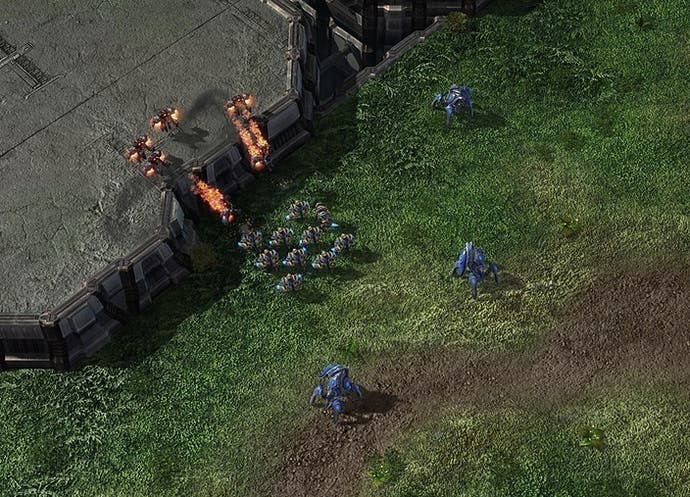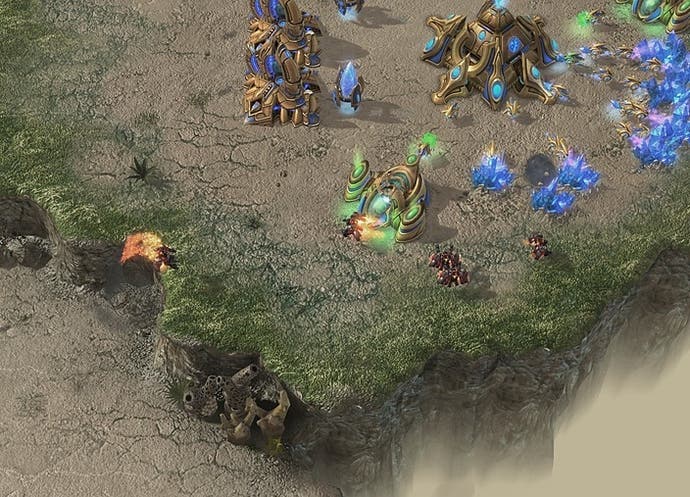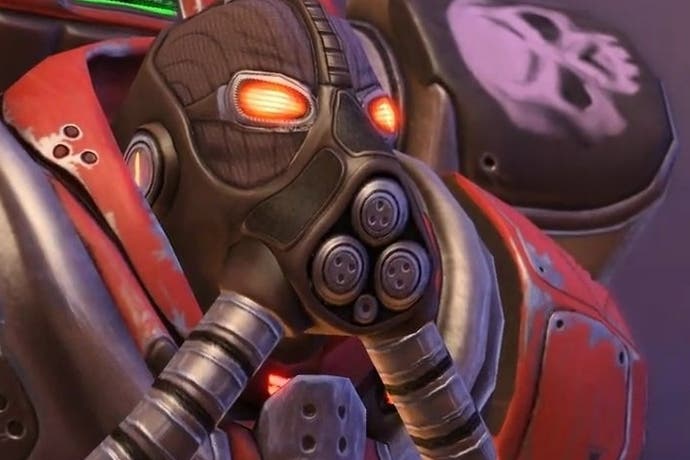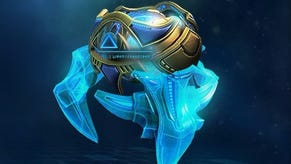Fear the Reaperman
How Blizzard makes bad designs good.
My fellow Terrans, sunny and glorious was the day that Eurogamer allowed me to write about the greatest race in strategy gaming history. Finally, I can tell it like it is. The release of Heart of the Swarm has put Starcraft 2 in a very happy place. In short, it's a hit with both players and pros, and also manages to be an even more exciting spectacle than Wings of Liberty. Blizzard's ever-evolving design for the game is fascinating to watch, and one of the key changes in HotS - from the perspective of the galaxy's greatest race, anyway - brought an end to the Reaper's long and lonely journey.
The Reaper is one of the most altered units in Starcraft 2's history. This means that, for much of its life in a competitive game, it was a failing design. The changes were legion and, in looking at how they affected Starcraft 2, this dinky jet-packed psycopath shows a wider arc. At different times it's been over-designed, stripped-back, buffed, nerfed, while being given strange powers along the way.
The first thing to emphasise is what a big deal it is for a game like Starcraft 2 to have a bad unit. It just wouldn't matter in other strategy games - no-one would use it, and that would be the end. Starcraft 2 is different because it is the gold standard for eSports, which is to say competitive gaming, and built from a limited number of pieces - each race has about 15 units.

If one of them's poor that affects not just a player's likelihood to build and use that unit, but also their opponent's play - it shifts the whole metagame. Take the Reaper's construction as an example: in Wings of Liberty it is built at a Barracks with a tech lab attached. If an opponent in Wings of Liberty's mature era saw that building they would never expect to see a Reaper; instead, they'd begin preparing to deal with Marauders. That can lead to its own set of mind games, of course, but very rarely does it. The overriding point is simple: having one bad unit, in Starcraft 2 at least, dulls a lot of other interactions and makes the game more predictable.
At the very beginning of Starcraft 2, when it was in beta, the Reaper was not a bad unit at all. In fact it was, to use the parlance, 'OP' - an overpowered option that threatened to unbalance the entire experience. The Reaper's concept, as held in the name, was as a dual-purpose raiding and scouting unit. Coming from a tech lab, the first production building available to the Terran army, it could be on the field of play very early in a game. And the Reaper had a unique ability: a jetpack that allowed it to hop up and down cliffs, which combined with a high default speed meant offensive mobility.
There were a few kinks to the Reaper that made it an incredibly effective unit to mass. The first was the extra damage it did to light units - which, in the early game, is all that Zerg really has. This was intended to make the Reaper especially efficient at sneaking behind and dealing damage to all worker lines, but its effect was that players used mass Reaper builds and overwhelmed Zergs that couldn't realistically deal with their manoeuvrability and firepower. At this time an upgrade, 'Nitro Packs', could be researched fairly quickly that made things even worse. These were the glory days, when the Reaper reigned supreme over the whole Zerg race.
Starcraft 2's developers had to do something, and they whipped out the nerf gun. The Nitro Packs upgrade was at different stages removed entirely and made less accessible, meaning the unit couldn't be quite as fast quite as quickly - though the only effect of this was players stopped getting the upgrade entirely. There was fiddling with things like build times, but movement speed is where the damage was done. The Reaper's decreased movement turned it into a unit that was still quite useful, but only in a very short window - that early game period when an opponent only has a few units of his own and undefended worker lines.

The loss of speed for the Reaper brought to the fore other problems. Terrans had access to the Hellion, a dual-purpose scouting and raiding unit, and it now outperformed the Reaper in a similar role in almost every respect - as well as costing 100 minerals, as opposed to the Reaper's 50 minerals 50 gas (which is a more valuable resource). Hellions could take more damage, deal more damage in most cases, moved faster, and were useful all through the game. You could get out a Reaper slightly faster, but players decided that wasn't enough.
As for its role in the metagame, the Reaper had odd abilities that it never quite suited. It had a satchel charge that does extra damage to buildings, which I'd conjecture was intended to give it a mid-to-late game base-raiding utility - one that, regardless, was never realised. There was an element of the glass cannon to the Reaper, but the balance between risk and reward was never right at any point; it felt too fragile, never powerful or useful enough.
This is not absolute, but after the very early days in Wings of Liberty you rarely saw the Reaper - I clocked them in the Global Starcraft League maybe twice. Among the glorious branches of Wings of Liberty's tech trees, it's a rather misshapen offshoot.
Starcraft 2's lead designer Dustin Browder talked about this contemporaneously at GDC 2011: "The Reaper is not in a happy place. It was a bit of a misstep for us. The players showed us what it was capable of and we nerfed it into obscurity. This will be addressed in Heart of the Swarm." When Browder was referring to the Reaper's capabilities, one suspects, he's thinking about the halcyon days of the 5 Barracks Reaper versus Zerg, an unbelievably powerful build that splatted those bugs but good.

How did Blizzard address the Reaper? It gave up tinkering and went for the throat. The unit's problems in Wings of Liberty had been responded to with mostly alterations to its existing capabilities - an increase here, a decrease there. For Heart of the Swarm the Reaper's role in the Terran army and the wider game was completely reconfigured, and over the beta substantial changes to its abilities were introduced and, in some cases, removed.
By far the most significant was the addition of passive regeneration; a mechanic whereby the Reaper, after being out of battle for ten seconds, regenerates its own health quickly. This is clearly a massive buff, but combines with one big nerf - the Reaper no longer does extra damage to light units, or has satchel charges, but does a relatively low 4 damage per shot from its dual pistols. This is damage, to be sure, but it means the Reaper takes ages to kill anything unless you've massed up quite a few of them (sound familiar?) Even then, it's isolated units only.
Another change seemed even stranger, but has turned out brilliantly - the Reaper no longer needs a tech lab. These add-ons are something the Terran has to make to get certain units out of basic production buildings. So now you can get one out even earlier, or even multiple. So now the Reaper is a unit that doesn't deal much damage, but can move quickly and - even though it has low health - heal quickly.
The beauty of these changes to the Reaper is that, in nerfing damage output, it has made it much more of a tactical unit than ever before - one that twists the original concept into something more useful than in Wings of Liberty, for sure. To illustrate this let us worship at the altar of Flash. One of the Brood War scene's all-time greats, a man worthy of the description bonjwa, Flash now plays Heart of the Swarm and recently opened up at MGL versus Zerg with Reapers into expansion - the follow-up being Hellions, of all units. If you wanted proof that Blizzard somehow drew a line between the unit's confused roles, there is no better example than the best of the best using both in an opening. I'd skip the first minute of this.
This game shows that the Reaper now has a characteristic essential for a good Starcraft unit; it can have great micro wars that depend on intimate player concentration, and is at its most effective when used constantly. Many other players would have lost those units early, but the control of Flash is such they deal damage and remain effective for a very long portion of the game - such potential, executed upon, is the cornerstone of competitive gaming.
Starcraft 2's metagame is not something you can make sweeping statements about. It is a landscape that, to poor fools like me, is built on shifting sands. But Blizzard's success in changing the Reaper also demonstrates the overall success of Heart of the Swarm - in building on the fundamentals of a brilliant game, one good enough to be an eSport, and then somehow making Wings of Liberty feel like a dry run.
WoW never grabbed me the way it did some people, and I didn't like Diablo 3. But every time someone talks about Blizzard as great designers, countless examples of little tweaks they've made to Starcraft 2 flood my mind. It's a game that is changed all the time, in an ever-onwards flow of patches, and played all the time. Its failures and successes are public affairs. In looking at the Reaper, how its concept was dulled and then revived through incremental steps, you can see the reflection of the grander vision behind it - that glorious, interlocking system that underpins the Terran Dominion. And in looking at how Starcraft 2's evolution is so expertly handled perhaps, too, we catch a glimpse of the company behind it.










